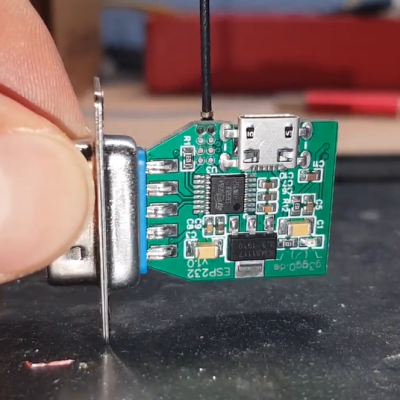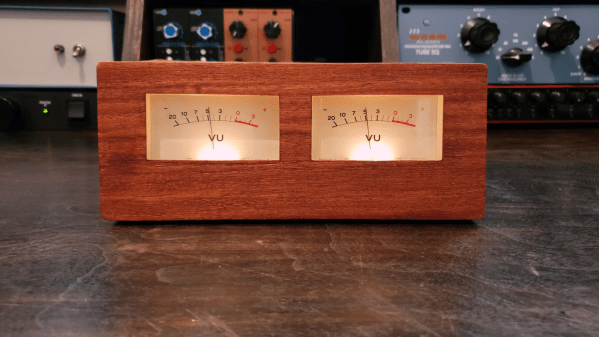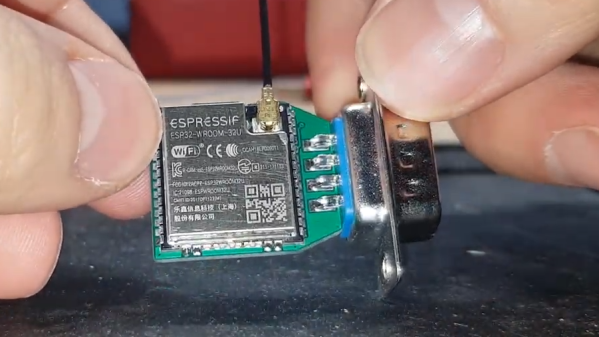The Great American Eclipse v2.0 has come and gone, sadly without our traveling to the path of totality as planned; family stuff. We did get a report from friends in Texas that it was just as spectacular there as expected, with the bonus of seeing a solar flare off the southwest limb of the disk at totality. Many people reported seeing the same thing, which makes us a bit jealous — OK, a lot jealous. Of course, this presented an opportunity to the “Well, ackchyually” crowd to point out that there were no solar flares or coronal mass ejections at the time, so what people saw wasn’t an exquisitely timed and well-positioned solar flare but rather a well-timed and exquisitely positioned solar prominence. Glad we cleared that up. Either way, people in the path of totality saw the Sun belching out gigatons of plasma while we had to settle for 27% totality.
bridge18 Articles
Salvaged Meter Movements Really Pop In This DIY VU Meter Bridge
If you’re going to build a nice VU meter bridge for the recording studio, the first thing you need is a nice pair of VU meters. But lest you think it’s as easy as putting some meters into a nice box and calling it a day, think again.
This project comes to us from [Frank Olson], whose projects usually incorporate wood as part of the mechanism, as with his famous wooden ribbon microphone. This build does indeed use wood, and to excellent effect, but only in the project’s final enclosure. Before that, [Frank] had salvaged a pair of good-looking moving coil meters from an old tape recorder. He muddled through some ideas before settling on a design. A NE5532 dual-channel audio buffer module is used as a preamp, with each channel feeding into a bridge rectifier before heading to the meter. Wisely, [Frank] chose to illuminate the meters with their existing incandescent bulbs, so a small DC-DC supply was added to provide the necessary 8 volts.
As for the enclosure, that’s where [Frank]’s experience working with veneers paid off. He chose mahogany, carefully cut all the pieces to shape with a knife, and glued it all up with CA glue — at least we assume it was CA; based on previous efforts, he uses a lot of the stuff. The tung oil finish looks fantastic, and the completed build aesthetic looks great! The video below shows it all.
If you need some backstory on the VU meter, we can help with that.
Continue reading “Salvaged Meter Movements Really Pop In This DIY VU Meter Bridge”
Building Bridges In This Week’s Hack Chat
In the electronics world, even for the hobbyists, things have only gotten smaller over the years. We went from through-hole components to surface mount, and now we’re at the point where the experienced DIYers are coming around to the idea of using ball grid array (BGA) components in their designs. We’d wonder what things are going to look like in another couple decades, but frankly, it gives us the heebie-jeebies.
So while we’re pretty well versed these days in the hows and whys of tiny things, we see comparatively little large-scale engineering projects. Which is why we were excited to have Andy Oliver stop by this week for the Heavy Engineering Hack Chat. His day job sees him designing and inspecting the control systems for movable bridges — or what many would colloquially refer to as drawbridges.
Now you might think there’s not a lot of demand for this particular skill set, but we’re willing to bet there’s a lot more of these bridges out there than you realized. Andy kicked things off with the revelation that just between the states of Florida and Louisiana, there are about 200 movable bridges of various sizes. On a larger scale, he points out that BridgeHunter.com lists an incredible 3,166 movable bridges in their database, though admittedly many of those are historical and no longer standing. (There really is a site for everything!)

There’s also a huge incentive to keep the existing bridges functioning for as long as possible — building a new one these days could cost hundreds of millions of dollars. Instead, repairs and upgrades are the name of the game. Andy says that if it’s properly maintained, you should get about a century out of a good bridge.
It will probably come as little surprise to find that keeping things as simple as possible is key to making sure a movable bridge can withstand the test of time. While we might imagine that all sorts of high-tech automation systems are at work, and they probably would be if any of us were in charge, Andy says that most of the time it’s old school relay logic.
Even controlling the speed of motors is often down to using beefy relays to switch some additional resistance into the circuit. But when reliability and ease of repair are top priorities, who’s to argue against a classic? Andy recalled a time when a government client made it clear that the only tool you should need to maintain a particular bridge’s control system was a hammer.
Of course, when moving around a million pounds of steel, there’s more than just electrical considerations at play. You’ve also got to take into account things like wind forces on the bridge, specifically that your gears and motors can handle the extra load without tearing themselves apart. The bridge also needs an emergency stop system that can arrest movement at a moment’s notice, but not damage anything in the process.
A lot of fascinating details about these motorized behemoths were covered in the Chat, so we’d invite anyone who’s ever watched a bridge slowly reconfigure itself to peruse through the full transcript. Special thanks to Andy Oliver for stopping by and sharing some of the details about his unique career with the community, and remember that if you’ve got your own engineering stories to tell, we’d love to hear them.
The Hack Chat is a weekly online chat session hosted by leading experts from all corners of the hardware hacking universe. It’s a great way for hackers connect in a fun and informal way, but if you can’t make it live, these overview posts as well as the transcripts posted to Hackaday.io make sure you don’t miss out.
Walk The First 3D-Printed Bridge And Be Counted
Way back in 2018, we brought you news of a 3D-printed stainless steel pedestrian bridge being planned to span a Dutch canal in Amsterdam. Now it’s finally in place and open to the public — the Queen made it official and everything. MX3D printed it on their M1 Metal additive manufacturing machine that is essentially a group of robots welding layers of metal together using traditional welding wire and gas.
The partnership of companies involved originally planned to build this beautiful bridge in situ, but safety concerns and other issues prevented that and it was built in a factory instead. The bridge has been printed and ready since 2018, but a string of delays got in the way, including the fact that the canal’s walls had to be refurbished to accommodate it. Since it couldn’t be made on site, the bridge was taken there by boat and placed with a crane. After all this, the bridge is only permitted to be there for two years. Hopefully, they have the option to renew.
This feat of engineering spans 40 feet (12.2 meters) long and sits 20 feet (6.3 meters) wide. It’s equipped with sensors that measure structural stuff like strain, displacement, load, and rotation, and also has environmental sensors for air quality and temperature. All of this data is sent to the bridge’s digital twin, which is an exact replica in the form of a computer model. One of the goals is to teach the bridge how to count people. Be sure to check out our previous coverage for a couple of short videos about the bridge.
DIY Wireless Serial Adapter Speaks (True) RS-232
There is a gotcha lurking in wait for hackers who look at a piece of equipment, see a port labeled “Serial / RS-232”, and start to get ideas. The issue is the fact that the older the equipment, the more likely it is to be a bit old-fashioned about how it expects to speak RS-232. Vintage electronics may expect the serial data to be at bipolar voltage levels that are higher than what the typical microcontroller is used to slinging, and that was the situation [g3gg0] faced with some vintage benchtop equipment. Rather than deal with cables and wired adapters, [g3gg0] decided to design a wireless adapter with WiFi and Bluetooth on one end, and true RS-232 on the other.
 The adapter features an ESP32 and is attached to a DB-9 plug, so it’s nice and small. It uses the ST3232 chip to communicate at 3 V logic levels on the microcontroller side, supports bipolar logic up to +/-13 V on the vintage hardware side, and a rudimentary web interface allows setting hardware parameters like baud rate. The nice thing about the ST3232 transceiver is that it is not only small, but can work from a 3 V supply with only four 0.1 uF capacitors needed for the internal charge pumps.
The adapter features an ESP32 and is attached to a DB-9 plug, so it’s nice and small. It uses the ST3232 chip to communicate at 3 V logic levels on the microcontroller side, supports bipolar logic up to +/-13 V on the vintage hardware side, and a rudimentary web interface allows setting hardware parameters like baud rate. The nice thing about the ST3232 transceiver is that it is not only small, but can work from a 3 V supply with only four 0.1 uF capacitors needed for the internal charge pumps.
As for actually using the adapter, [g3gg0] says that the adapter’s serial port is exposed over TCP on port 23 (Telnet) which is supported by some programs and hardware. Alternately, one can connect an ESP32 to one’s computer over USB, and run firmware that bridges any serial data directly to the adapter on the other end.
Design files including schematic, bill of materials, and PCB design are shared online, and you can see a brief tour of the adapter in the video, embedded below.
Continue reading “DIY Wireless Serial Adapter Speaks (True) RS-232”
Wall-Climbing Robot Grabs Prize
Gravity is a nice thing to have most of the time, but sometimes it would be nice to be able to ignore it for certain applications. Rock climbing, for example, would be much easier, as would performing bridge inspections in the way that a group of mechanical engineering cadets (students) at The Citadel, a military college in South Carolina, were tasked with doing. Frustrated with the amount of traffic backups that normal bridge inspections caused, they invented a robot that defies gravity, and won a $10k prize for their efforts.
The result is essentially an RC car with a drone built in, or looking at it another way it’s a drone with wheels. The car is able to drive on vertical surfaces to inspect the bridges by using its propellers to force itself onto the surface. The lack of complicated moving parts or machinery, like a cable suspension system or other contraption, makes this device exceptionally versatile for the task at hand, reduces the amount of time needed for inspections, and can do them more safely and without closing lanes of traffic. The group hopes to build a second prototype soon and present it to the Department of Transportation for approval for more widespread use.
The need for tools like these is in high demand now as well, especially in the United States where crumbling infrastructure is often not thought about, taken seriously, or prioritized. Even for bridges that aren’t major pieces of infrastructure, tools like these will prove to be very useful.
Thanks to [Ben] for the tip!
3D Printed Bridge Goes Dutch
If you’ve ever been to Amsterdam, you know there are plenty of canals and, therefore, plenty of bridges. Next year, a unique pedestrian bridge in the old city center will go into service. The stainless steel bridge will be 3D printed and also embed a number of sensors that will collect data that the printer — MX3D — and their partners Autodesk, the Alan Turing Institute, and the Amsterdam Institute for Advanced Metropolitan Studies, hope will help produce better 3D printed structures in the future. The bridge will cross the Oudezijds Achterburgwal which is near the city’s infamous red light district.
Since the bridge matches exactly with the model used to print it, scientists hope to be able to map the sensor data to a virtual twin of the bridge very easily. You can see a few videos about the bridge’s construction below. This month, during Dutch Design Week, visitors had a chance to walk across the bridge to generate some of the first live datasets.


















